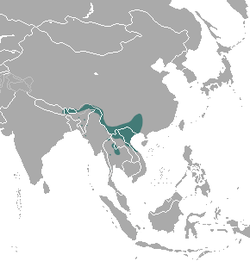Characteristics
The back-striped weasel is distinguished from all other Mustela species by the presence of a narrow, silvery dorsal streak extending from the occiput almost to the root of the tail, with a corresponding yellowish ventral streak from the chest along the abdomen. The general colour of the dorsal surface varies from deep to paler chocolate brown, sometimes a little paler on the head and usually slightly darkened along the side of the dorsal streak. The tail and limbs are of the same hue as the back. The upper lip from the rhinarium, the chin and the throat up to the level of the ears are pale varying from whitish to ochreous. On the hind throat and fore chest, the pale hue gradually narrows in extent, and is quite narrow between the forelegs, where it passes into the ventral streak, which expands on the inguinal region between thighs. The pads of the feet are well developed, the plantar ads being four-lobed, with the area around them entirely naked. [2]
The bushy tail is rather long, being more than half the length of the head and body. The length of head and body of males is 30–36 cm (12–14 in), while the tail length is 18–20 cm (7.1–7.9 in). [3] A live-captured juvenile male was estimated to weigh only 700 g (1.5 lb). [4]
Distribution and habitat
The occurrence of the stripe-backed weasel has been confirmed from scattered localities in and around northeastern India, northern and central Myanmar, southern China, northern Thailand, northern and central Laos and Vietnam at an elevation range from sea level to 2,500 m (8,200 ft). It inhabits a wide variety of habitats, and it is not yet possible to define its habitat needs. Specimens collected came from dense hill jungle, hill evergreen forest, disturbed evergreen forest, lower montane evergreen forest and lowland evergreen forest. Most field sightings were in daylight. [3]
In India, it was recorded in Dampa Tiger Reserve in 1994, and in Namdapha National Park. [5] In Laos, two individuals were sighted in 2008, both near streams in evergreen forest in Nakai–Nam Theun National Biodiversity Conservation Area. [6]
This page is based on this
Wikipedia article Text is available under the
CC BY-SA 4.0 license; additional terms may apply.
Images, videos and audio are available under their respective licenses.


